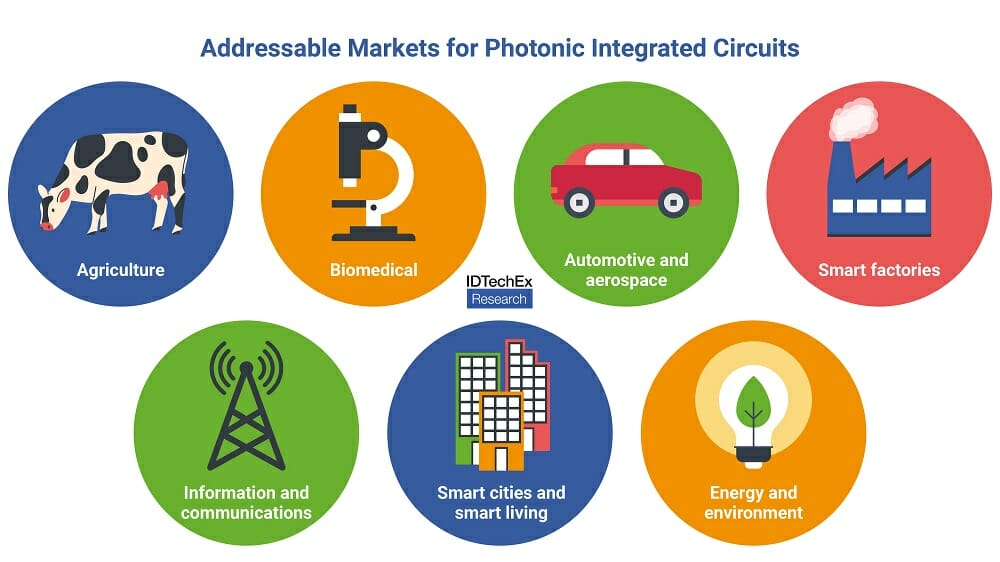Whatever the name – be that the humble ‘chip’, the slightly misleading ‘microchip’, the technically robust ‘semiconductor integrated circuit’, or the slightly less technically robust ‘integrated circuit’ – chips are everywhere; in laptops, mobile phones, TVs, automobiles, displays, and other electrical products a thousand times over.
Q4 2022 hedge fund letters, conferences and more
Chips are crucial to enabling the relative luxuries of the modern world. While most chips in usage today are electrical in nature, they are not the only physical systems in town. In the report “Semiconductor Photonic Integrated Circuits 2023-2033”, IDTechEx takes a close look at photonic chip-scale systems (which use light as the primary transmission signal, rather than electricity), examining the technology capabilities, key players involved with the design and manufacture of photonic integrated circuits (PICs), and the addressable markets.
Foremost among these markets is the communications industry, which currently accounts for more than the sum of all of the other addressable markets in terms of revenue generated. Yet, while the communications industry is certainly the principal driving force behind continued development in photonic chip-scale systems, IDTechEx notes that there are certain other markets where silicon photonics shows great promise as products enter the commercial space.

Silicon Photonics for Automotive LiDAR
LiDAR (Light Detection And Ranging) has been around for a while now – the first prototype being built in the 1960s – but it is only recently that silicon photonics has presented itself as an attractive platform for automotive LiDAR systems.
One way to differentiate LiDAR systems is via the beam steering technology they employ, be this mechanical, micro-electromechanical (MEMS), flash, optical phase array (OPA), or a specific combination (such as MEMS integrated with silicon photonics).
OPA LiDAR is the most common scanned solid-state technology developed globally, with Quanergy (the most established player) using a Near Infra Red (NIR) laser source and time-of-flight measurement process. Improvements to performance and sensing capabilities brought about by Short-Wave Infra Red (SWIR), and Frequency Modulated Continuous Wave (FMCW) detection are attractive enough for many companies to begin developing LiDAR systems employing these technologies.
FMCW detection is of particular import, as this method of detection (where the frequency of the outgoing light beam is changed with respect to time, a technique known as ‘chirping’) allows – via the doppler shift – accurate analysis of an obstacle’s velocity.
In addition to the typical three-dimensional sensing enabled by LiDAR, where time-of-flight measurements determine obstacles’ spatial locations, FMCW detection enables effective 4D mapping, which is a crucial technology for autonomous vehicles.
Given this, and the ability to scale such LiDAR systems down to the size of a chip, PICs are uniquely placed to gain a foothold in the automotive LiDAR market. IDTechEx quantifies this statement in the aforementioned report, whereby they note that the forecast compound annual growth rate (CAGR) for PIC automotive LiDAR between 2025 and 2033 exceeds that of PICs for the communications industry over the same time period.
Point-of-Care PICs
Miniaturized devices that integrate light transmission, reception, and analysis within a single modular system could be especially useful for point-of-care diagnostics in clinics and hospitals, an area that IDTechEx identifies as being one in which PICs could see a notable uptake over the next ten years.
The ability to multiplex such that different biomarkers are addressed on different waveguides on a single chip would result in considerable bench space-saving and allow for improved multifunctional ease-of-use over incumbents, which include cartridges and continuous glucose monitors. This being said, there are significant challenges to PIC adoption, such as being able to match incumbent technologies at a similar price point.
Report Coverage
More information on PIC applications within the automotive and biomedical market segments is given in the IDTechEx report “Semiconductor Photonic Integrated Circuits 2023-2033”, where LiDAR, wearable sensors, kinaesthetic haptics, and point-of-care diagnostics are all detailed, and PIC uptake forecast with respect to incumbent technologies.
More generally, the report covers the global PIC market across six different application segments by giving a 10-year forecast for each, up to and including 2033, in terms of the market value of PIC systems.
Additionally, the report covers evaluations of materials used in PIC design and manufacture, the developments being undertaken by large companies and start-ups alike to improve on key metrics such as performance and cost from both a systems and architecture perspective, as well as a thorough review of the product offerings by key market players.
While the importance of photonic circuitry at the chip scale is already in evidence within the communications industry, there are questions around the ease and cost of adoption of PICs for other markets compared to incumbent technologies. IDTechEx’s report answers the major questions, challenges and opportunities faced by photonic integrated circuit technologies.
For further understanding of the markets, players, technologies, opportunities, and challenges, please visit www.IDTechEx.com/SemiPIC. Downloadable sample pages are available for this report.
About IDTechEx
IDTechEx guides your strategic business decisions through its Research, Subscription and Consultancy products, helping you profit from emerging technologies. For more information, contact [email protected] or visit www.IDTechEx.com.













